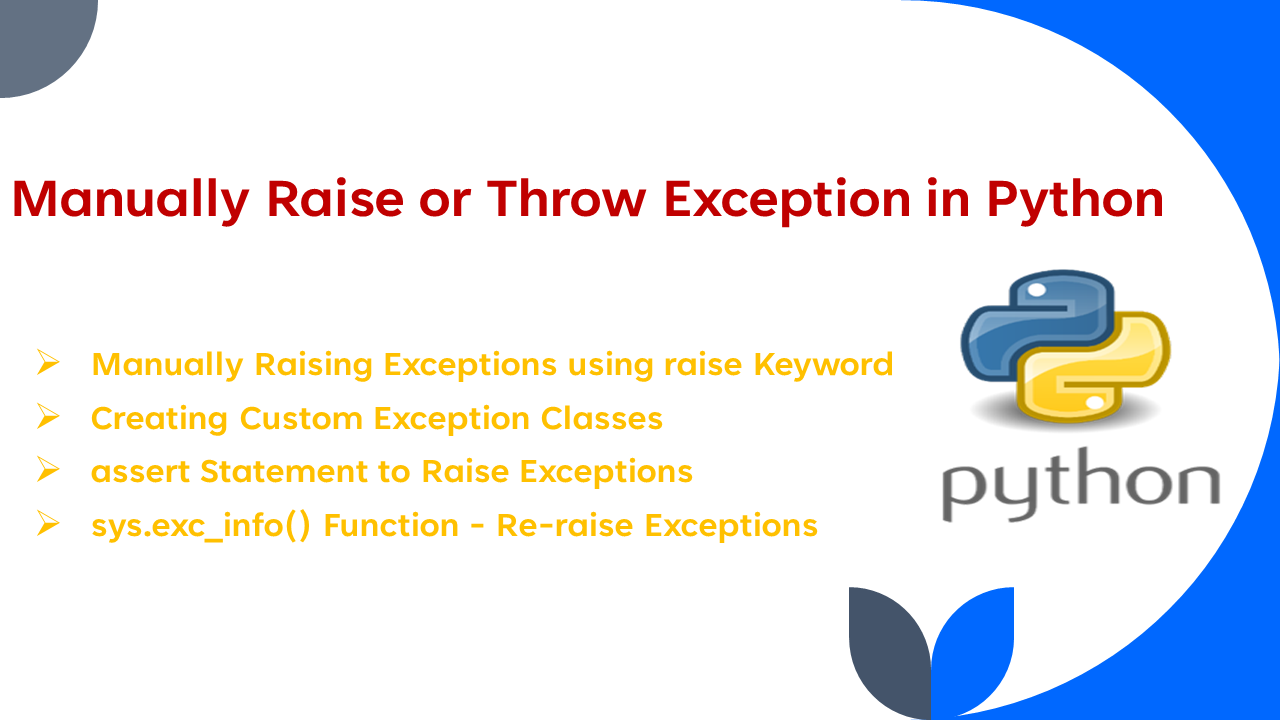Python Raise Exception: A Guide to Manually Throwing Errors
Learn how and why to manually raise exceptions in Python to improve your code's error handling and debugging capabilities.
Learn how and why to manually raise exceptions in Python to improve your code's error handling and debugging capabilities.
In Python, the raise keyword allows you to manually signal errors, interrupting the normal program flow when specific conditions arise. This is useful for handling unexpected situations and preventing potential crashes. You can raise exceptions with custom messages or utilize Python's built-in exception types like ValueError and TypeError for more specific error reporting. Furthermore, you can define your own custom exception types tailored to your application's needs. The raise keyword is often used in conjunction with try...except blocks, enabling you to gracefully handle exceptions, log errors, or display user-friendly messages, preventing abrupt program termination.
In Python, you can manually signal an error using the raise keyword. This is often done to interrupt the normal flow of a program when a specific condition, which you define, is met.
Think of it like raising a flag to say "Hey, something's not right here!".
You can raise an exception with a generic message like this:
raise Exception("Something went wrong!")This will stop your program and print out the message "Something went wrong!".
However, it's more helpful to be specific about the type of error. Python has built-in exceptions like ValueError, TypeError, and IndexError that you can use:
raise ValueError("The input must be a positive number!")This not only stops your program but also gives a clear reason for the problem, making it easier to debug.
You can even define your own custom exception types by creating a new class that inherits from the base Exception class. This is useful for situations specific to your application.
The raise keyword is often used within a try...except block. This allows you to handle the exception gracefully, perhaps by logging the error or displaying a user-friendly message, instead of letting the entire program crash.
The code demonstrates Python exception handling using try...except blocks. It shows examples of raising generic exceptions, specific built-in exceptions like ValueError, and defining and raising custom exceptions. The code includes functions for dividing numbers, validating age input, and checking email format, each raising an exception for invalid input. The try...except blocks catch these exceptions, preventing program crashes and printing informative error messages.
# Example 1: Raising a generic exception
def divide(x, y):
if y == 0:
raise Exception("Cannot divide by zero!")
return x / y
# Example 2: Raising a specific built-in exception
def get_age(age):
if age < 0:
raise ValueError("Age cannot be negative.")
return age
# Example 3: Defining and raising a custom exception
class InvalidEmailError(Exception):
"""Raised when an email address has an invalid format."""
pass
def validate_email(email):
if "@" not in email:
raise InvalidEmailError("Invalid email format.")
return email
# Using try...except to handle exceptions
try:
print(divide(10, 0)) # This will raise an exception
except Exception as e:
print(f"Error: {e}")
try:
print(get_age(-5)) # This will raise a ValueError
except ValueError as e:
print(f"Error: {e}")
try:
validate_email("invalid_email") # This will raise a custom exception
except InvalidEmailError as e:
print(f"Error: {e}")Explanation:
divide(x, y) function:
x by y.y is 0, it raises a generic Exception with a message explaining the issue.get_age(age) function:
age is negative.ValueError with a specific message.InvalidEmailError custom exception:
Exception class.validate_email(email) function:
email contains an "@" symbol.InvalidEmailError.try...except blocks:
try block encloses code that might raise an exception.except block catches the specific exception type and prints an error message.raise. It's generally better to handle predictable errors gracefully within your code rather than constantly raising exceptions.from keyword to indicate the original cause of an error. This is helpful for tracing back exceptions through multiple function calls.raise without an argument within an except block to re-raise the caught exception.raise:
assert): Use assertions to check for conditions that must be true for your code to function correctly. Assertions are typically used for debugging and testing.Remember: Effective exception handling is crucial for writing robust and reliable Python code. Understanding how and when to use raise is a key part of this.
| Feature | Description | Example |
|---|---|---|
raise keyword |
Interrupts normal program flow to signal an error. | raise Exception("Something went wrong!") |
| Generic Exceptions | Use the Exception class for a general error message. |
raise Exception("Invalid input!") |
| Specific Built-in Exceptions | Utilize Python's built-in exceptions like ValueError, TypeError, etc., for clearer error messages. |
raise ValueError("The input must be a positive number!") |
| Custom Exceptions | Define your own exception types by inheriting from the Exception class for application-specific errors. |
class InvalidInputError(Exception): pass |
try...except Block |
Handle raised exceptions gracefully, preventing program crashes. | try: ... except ValueError: print("Please enter a valid value.") |
Key takeaway: Using raise with specific exception types helps in creating robust and debuggable Python code.
By using the raise keyword effectively, you can improve your error handling, make your code more robust, and simplify the debugging process. Remember to choose the most appropriate exception type, provide informative error messages, and use try...except blocks to handle exceptions gracefully. Mastering Python's exception handling mechanisms, including the raise keyword, is essential for writing reliable and maintainable Python applications.
 Here is how to manually raise an exception in Python | To manually raise an exception in Python, you can use the raise keyword. This keyword allows you to throw an exception with a custom error message.
Here is how to manually raise an exception in Python | To manually raise an exception in Python, you can use the raise keyword. This keyword allows you to throw an exception with a custom error message. How to manually raising (throwing) an exception in Python? | Better ... | Better Stack lets you see inside any stack, debug any issue, and resolve any incident.
How to manually raising (throwing) an exception in Python? | Better ... | Better Stack lets you see inside any stack, debug any issue, and resolve any incident. Python Raise an Exception | W3Schools offers free online tutorials, references and exercises in all the major languages of the web. Covering popular subjects like HTML, CSS, JavaScript, Python, SQL, Java, and many, many more.
Python Raise an Exception | W3Schools offers free online tutorials, references and exercises in all the major languages of the web. Covering popular subjects like HTML, CSS, JavaScript, Python, SQL, Java, and many, many more. Manually Raise or Throw Exception in Python - Spark By {Examples} | How to manually raise or throw an exception in Python? You may want to manually raise or throw an exception to signal that an error has occurred or to
Manually Raise or Throw Exception in Python - Spark By {Examples} | How to manually raise or throw an exception in Python? You may want to manually raise or throw an exception to signal that an error has occurred or to How to Throw Exceptions in Python | Rollbar | This guide is the ultimate resource for Python developers who want to design, implement, and maintain applications that can deal with errors properly.
How to Throw Exceptions in Python | Rollbar | This guide is the ultimate resource for Python developers who want to design, implement, and maintain applications that can deal with errors properly. Dunder method throw for Exceptions object behavior - Ideas ... | Hi everyone, I would have had an idea. In a “very” specific case, I had to throw a raise Exception and before panicking, create a file. This behavior is obviously not expected by the default BaseException object. In my case I handled it by creating an ad-hoc function that executed code before creating and throwing the exception. I thought it was possible to create a dunder method throw where you can insert additional behavior that the raise keyword performs (or evaluates) before throwing the...
Dunder method throw for Exceptions object behavior - Ideas ... | Hi everyone, I would have had an idea. In a “very” specific case, I had to throw a raise Exception and before panicking, create a file. This behavior is obviously not expected by the default BaseException object. In my case I handled it by creating an ad-hoc function that executed code before creating and throwing the exception. I thought it was possible to create a dunder method throw where you can insert additional behavior that the raise keyword performs (or evaluates) before throwing the... Python Throw Exception | Tips for Python Custom Exception | Discover efficient Python throw exception methods with the raise() function and how to implement try except Python blocks for error handling!
Python Throw Exception | Tips for Python Custom Exception | Discover efficient Python throw exception methods with the raise() function and how to implement try except Python blocks for error handling! How To Manually Raise An Exception In Python | Learn how to raise an exception manually in Python with simple language explanations and examples.
How To Manually Raise An Exception In Python | Learn how to raise an exception manually in Python with simple language explanations and examples.